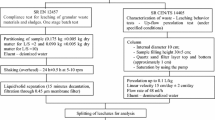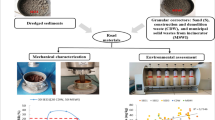Abstract
With regards to European waste catalog, automotive shredder residues (ASR) can be classified both as a hazardous or non-hazardous waste according to its hazardous properties (H1–H14). It is thus important to carry out an adequate chemical-physical characterization to identify the presence and concentration of those substances able to give, to this extremely heterogeneous material, the hazardousness character of. The issue of waste characterization, to identify the proper site for appropriate waste disposal, is based, according to the relevant laws, to the use of leaching tests. The analysis of the potential effects of landfilled waste in laboratory, however, run into several difficulties in reproducing phenomena depending both on the characteristics of small, heterogeneous quantity of waste and on the local boundary conditions. These difficulties are much more significant as the waste is heterogeneous at the small scale of the laboratory. This is one of the main problems often leading to scattered results even when starting from the same waste parcel. Present research aimed to overcome the above-mentioned difficulties deriving from waste heterogeneity and was based on a lysimetric simulation. Experimentation with lysimeter has shown it effectiveness in the comparison between leachate from the lysimeter and an ASR landfill leachate, from which similar distribution of metal mass ratios, close values for both BOD5 and COD, as well as the absence in both the fluids of organochlorinated compounds, emerge.



Similar content being viewed by others
References
Altay MC, Nüket S, Burcu O, Ülkü Ş, Zorağa M, Altay HK (2011) Recycle of metals for end-of-life vehicles (ELVs) and relation to Kyoto protocol. Renew Sust Energ Rev 15(5):2447–2451
Bruyère D, Simon S, Haas H, Conte T, Menad N (2016) Cryogenic ball milling: a key for elemental analysis of plastic-rich automotive shedder residue. Powder Technol 294:454–462
Buekens A, Zhou X (2014) Recycling plastics from automotive shredder residues: a review. J Mater Cycles Waste Manage 16(3):398–414
Chang EE, Chiang PC, Lu PH, Ko YW (2001) Comparisons of metal leachability for various wastes by extraction and leaching methods. Chemosphere 45:91–99
Cioca LI, Ivascu L (2015) Characterization of automotive shredder residues before and five years after landfill disposal. Rev. Ambient. e Agua 10(2):253–262
Cossu R, Lai T (2013) Washing treatment of automotive shredder residue (ASR). Waste Manag 33:1770–1775
Cossu R, Lai T (2015) Automotive shredder residue (ASR) management: an overview. Waste Manag 4:143–151
Cossu R, Fiore S, Lai T, Luciano A, Mancini G, Ruffino B, Viotti P, Zanetti MC (2014) Review of Italian experience on automotive shredder residue characterization and management. Waste Manag 34(10):1752–1762
Directive 2000/53/EC (n.d.) of the European Parliament and of the Council of 18 September 2000 on end-of life vehicles
Fällman AM, Aurell B (1996) Leaching tests for environmental assessment of inorganic substances in wastes, Sweden. Sci Total Environ 178:71–84
Ferella F, De Michelis I, Scocchera A, Pelino M, Veglio F (2015) Extraction of metals from automotive shredder residue: preliminary results of different leaching systems. Chin J Chem Eng 23(2):417–424
Fonseca AS, Nunes MI, Matos MA, Gomes AP (2013) Environmental impacts of end-of-life vehicles management: recovery versus elimination. Int J Life Cycle Assess 18(7):1374–1385
Gonzalez-Fernandez O, Hidalgo M, Margui E, Carvalho ML, Queralt I (2008) Heavy metals’ content of automotive shredder residues (ASR): evaluation of environmental risk. Environ Pollut 153:476482
Gonzalez-Fernandez O, Pessanha S, Queralt I, Carvalho ML (2009) Analysis of lead content in automotive shredder residue (ASR). Waste Manag 29(9):2549–2552
Hohberg I, De Groot GJ, Van der Veen AMH, Wassing W (2000) Development of a leaching protocol for concrete. Waste Manag 20:177–184
Joung H, Seo Y, Kim K (2007) Distribution of dioxins, furans, and dioxin-like PCBs in solid products generated by pyrolysis and melting of automobile shredder residues. Chemosphere 68:1636–1641
Juma H, Dalibor S (2015) Characterization of automobile shredder residue for purpose of its thermal conversion. J Solid Waste Technol Manag 41(1):41–49
Kurose K, Okuda T, Nishijima W, Okada M (2006) Heavy metals removal from automobile shredder residues (ASR). J Hazard Mater 137(3):1618–1623
Mancini G, Viotti P, Luciano A, Raboni M, Fino D (2014a) Full scale treatment of ASR wastes in a modified rotary kiln. Waste Manag 34(11):2347–2354
Mancini G, Viotti P, Luciano A, Fino D (2014b) On the ASR and ASR thermal residues characterization of full scale treatment plan. Waste Manag 34(2):448–457
Ohno H, Matsubae K, Nakajima K, Kondo Y, Nakamura S, Fukushima Y, Nagasaka T (2017) Optimal recycling of steel scrap and alloying elements: input-output based linear programming method with its application to end-of-life vehicles in Japan. Environ Sci Technol 51(22):13086–13094
Primavera A, Braga D, Tiburzio S, Faraci E (2017) Automotive shredder residue: mixed plastic recyclability as carbon substitute into the EAF. Waste Manag 137(2):33–41
Qianga T, Heejong K, Kazuto E, Takeshi K, Toru I (2015) Size effect on lysimeter test evaluating the properties of construction and demolition waste leachate. Soils Found 55(4):720–736
Restrepo E, Løvik AN, Wäger P, Widmer R, Lonka R, Müller DB (2017) Stocks, flows and distribution of critical metals in embedded electronics in passenger vehicles. Environ Sci Technol 51(3):1129–1139
Sakai S, Urano S, Takatsuki H (2000) Leaching behavior of PCBs and PCDDs/Dfs from some waste materials. Waste Manag 20:241–247
Scheutz C, Fredenslund AM, Nedenskov J, Kjeldsen P (2010) Release and fate of fluorocarbons in a shredder residue landfill cell: 1. Laboratory experiments. Waste Manag 30(11):2153–2162
Singh J, Lee BK (2016) Recovery of precious metals from low-grade automobile shredder residue: a novel approach for the recovery of nanozero-valent copper particles. Waste Manag 48:353–365
Vermeulen I, Van Caneghem J, Block C, Baeyens J, Vandecasteele C (2011) Automotive shredder residue (ASR): reviewing its production from end-of-life vehicles (ELVs) and its recycling, energy or chemicals’ valorisation. J Hazard Mater 190:8–27
Viguri J, Andrés A, Ibanez R, Ruiz Puente C, Irabien A (2000) Characterization of metal finishing sludges: influence of the pH. J Hazard Mater A79:63–75
Zanetti MC, Genon G (1999) Physical properties of industrial wastes: laboratory tests. Resour Conserv Recycl 25:95–213
Author information
Authors and Affiliations
Corresponding author
Additional information
Responsible Editor: Philippe Garrigues
Publisher’s note
Springer Nature remains neutral with regard to jurisdictional claims in published maps and institutional affiliations.
Rights and permissions
About this article
Cite this article
Mancini, G., Luciano, A., Viotti, P. et al. Evaluation of automotive shredder residues (ASR) landfill behavior through lysimetric and traditional leaching tests. Environ Sci Pollut Res 27, 13360–13369 (2020). https://doi.org/10.1007/s11356-020-07788-3
Received:
Accepted:
Published:
Issue Date:
DOI: https://doi.org/10.1007/s11356-020-07788-3




